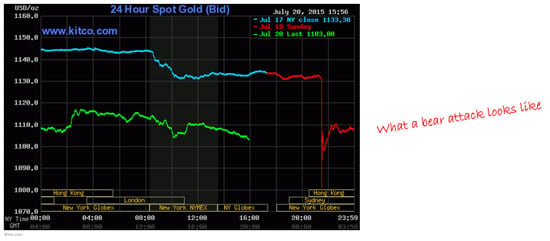The official story is that raw materials are losing their luster in recent weeks amidst signals from the Fed that it’s going to raise rates. The theory is that higher borrowing costs reduce the incentive to buy commodities by making them less attractive versus interest bearing instruments like bonds and equities that pay dividends because of the lost opportunity cost.
That makes sense but, as usual, it’s not the whole story.
[ad#Google Adsense 336×280-IA]For that you’ve got to look east to China where traders staged a classic “bear raid” Monday night to capitalize on low liquidity conditions created while Japanese markets were closed for Umi no hi, or Ocean Day, in Japan, a national holiday.
It’s Called a “Bear Raid,” and Here’s How It Works
Now, a bear raid is a highly technical tactic often used by large institutional traders.
The goal is to create windfall profits though short sales and futures contracts.
If it works, the targeted stock, bond, currency, or – in this case – commodity plunges, allowing the short sellers to buy back shares they’ve borrowed and sold earlier at a huge discount. Typically, the sellers work together to establish a massive sale that overwhelms buyers and inflicts huge losses on anybody who’s long.
In this case, traders took advantage of the fact that Japan’s markets were closed for a national holiday. They knew full well that, absent their money, there were even fewer buyers than usual to mount a defense.
And what a move it was!
More than 3 million lots traded on the Shanghai Gold Exchange; a normal day is less than 30,000 lots by comparison. Anybody who tried to hang on got clobbered.
 As for what’s next… that’s the interesting part.
As for what’s next… that’s the interesting part.
Traders took prices below $1,130 which was previously regarded as solid support. This strongly suggests that there’s more selling to come.
So, far from being a one-day crash, this could represent one of the best gold-buying opportunities of the year.
–Keith Fitz-Gerald
[ad#sa-generic]
Source: Money Morning


